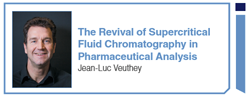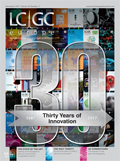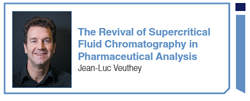The Revival of Supercritical Fluid Chromatography in Pharmaceutical Analysis
LCGC Europe
There has been a great renewal of interest in supercritical fluid chromatography (SFC) as a performing analytical tool for various types of applications recently. SFC is particularly suitable for pharmaceutical analysis, where it is required to have separation methods offering high throughput, elevated efficiency, and, importantly, sensitivity for the determination of drugs in various matrices, such as drug formulation and biological fluids. However, SFC has also been used for other applications, including food analysis, polymer analysis, and environmental analysis, as reported in a recent review.

There has been a great renewal of interest in supercritical fluid chromatography (SFC) as a performing analytical tool for various types of applications recently (1). SFC is particularly suitable for pharmaceutical analysis, where it is required to have separation methods offering high throughput, elevated efficiency, and, importantly, sensitivity for the determination of drugs in various matrices, such as drug formulation and biological fluids. However, SFC has also been used for other applications, including food analysis, polymer analysis, and environmental analysis, as reported in a recent review (2).
Since 2000, liquid chromatography (LC) has dramatically evolved to address these challenges, with the development of innovative stationary phases, including monoliths, sub-2-µm fully porous, and subâ3âµm superficially porous particles, packed in columns of reduced dimensions. As well as the development of stationary phases, LC instruments have also progressed: The upper pressure limit has been extended up to 1500 bar and their volumes, that is, dwell volume and extracolumn dead volume, have been drastically reduced (3). Furthermore, hyphenating LC with mass spectrometry (MS) using atmospheric pressure ionization (API) techniques allows increased selectivity and sensitivity. For all these reasons, LC–MS is now considered the workhorse for drug analysis. SFC–MS can be considered a complementary technique to LC–MS because it now offers some similar advantages: compatibility with modern stationary phases, optimized instrumentation, and interfaces for reliable and sensitive SFC–MS operation.
Historically, SFC was developed in the 1980s as an alternative technique to gas chromatography (GC) and LC because of its remarkable mobile phase properties. Indeed, a supercritical fluid, which is mostly CO2 in SFC, possesses a low viscosity and high solute diffusion coefficients similar to a gas phase. In addition, it has a solvating power close to that of a liquid phase, which can be easily modified by playing with its density (through changes in pressure and temperature), and by changing the nature and proportion of organic modifier added to the fluid. The first developments of SFC were performed with capillary columns and modified GC systems, and were able to withstand the required pressure to maintain the fluid, mainly pure CO2, in its supercritical state. At this time, SFC’s interesting mobile phase properties were viewed as a potential advantage to extend the applicability of GC in terms of analyzable substances. However, even if some successful applications were demonstrated, the poor robustness and reproducibility of the systems, together with a clear limitation in terms of applications with pure supercritical CO2, especially for drugs, induced a rapid decline of interest for capillary SFC. In 1983, the first SFC system compatible with packed columns (similar to the ones used in LC) was commercialized, and included a pumping unit for supplying liquid CO2 and a second pump for delivering the organic modifier in isocratic or gradient mode. Detection was performed with conventional detectors currently used in LC, such as ultraviolet (UV), and the coupling of packed column SFC with MS was also reported. It is worthy to note that an active back pressure regulator (BPR) was designed to maintain the system under pressure during the analysis, even in gradient mode. Numerous applications were reported in the literature for the analysis of various substances, including pharmaceuticals, but the interest of the community remained mostly limited to chiral separation and preparative or semipreparative applications, where SFC offers numerous advantages over LC and GC. Similar to capillary SFC, the main drawback of packed-column SFC was its lack of robustness and poor quantitative performance, in comparison with LC (especially reversed-phase LC), for the analysis of pharmaceuticals.
Only a few years after the acetonitrile shortage in 2008, several major providers of chromatographic instrumentation entered the SFC market and commercialized some innovative SFC instruments. These new apparatus were drastically improved in terms of robustness, thanks to the introduction of a novel BPR design. In addition, these new SFC instruments have the same features as ultrahigh-pressure liquid chromatography (UHPLC) systems, including an excellent injection repeatability, extended pressure limits, reduced extracolumn dead volume contribution, and improved detection sensitivity. Therefore, these SFC systems are compatible with columns packed with subâ2-µm fully porous and sub-3-µm superficially porous particles specially designed for SFC. The term UHPSFC, which stands for ultrahigh-performance supercritical fluid chromatography, was coined to describe the use of state-of-the-art columns and instruments in SFC (4). Numerous relevant applications have been recently reported in the literature, showing the significant potential of UHPSFC as a complementary analytical tool to UHPLC for drug analysis (5). However, some technical improvements are still needed, particularly in terms of injection time, pressure capability, and extracolumn dead volume contribution, to further improve the chromatographic performance. Moreover, more validated methods have to be reported to convince the pharmaceutical industry, as well as clinical and forensic laboratories, to implement this analytical technique routinely. Last, but not least, method transfer between columns of different dimensions is not as straightforward in SFC as in LC because pressure variations from one column to another can impact mobile phase density and temperature gradients, which affects the retention and selectivity (6).

As well as chiral analysis, which remains one of the key advantages of SFC over normal-phase LC, the possibility to perform analysis under gradient conditions varying from totally supercritical conditions (pure CO2) to purely liquid conditions (pure methanol) is certainly something to investigate in the future. As an example, this strategy has been successfully applied by Bamba et al. in 2014, for the separation of lipophilic and hydrophilic vitamins (with log P values ranging from -2 to 10), within a single run (7). This approach has been described under the name “unified chromatography”. It could also be valuable in metabolomics, where endogenous and exogenous substances as well as their metabolites presenting very diverse polarity have to be determined in biological matrices (8). Today, at least two or three LC modes have to be used to analyze all these substances contained in urine, plasma, or tissues. However, unified chromatography requires a system able to withstand pressures higher than the current 400–600 bar because of the high viscosity of methanol-rich mobile phases.
References
- E. Lesellier and C. West, J. Chromatogr. A1382, 2–46 (2015).
- A. Tarafder, Trends in Anal. Chem.81, 3–10 (2016).
- S. Fekete, J. Schappler, J.L. Veuthey, and D. Guillarme, Trends in Anal. Chem. 63, 2–13 (2014).
- A. Grand-Guillaume Perrenoud, J.L. Veuthey, and D. Guillarme, J. Chromatogr. A 1266, 158–167 (2012).
- V. Desfontaine, D. Guillarme, E. Francotte, and L. Novakova, J. Pharm. Biomed. Anal. 113, 56–71 (2015).
- A. Tarafder, C. Hudalla, P. Iraneta, and K.J. Fountain, J. Chromatogr. A1362, 278–293 (2014).
- K. Taguchi, E. Fukusaki, and T. Bamba, J. Chromatogr. A1362, 270–277 (2014).
- A. Sen, C. Knappy, M.R. Lewis, R.S. Plumb, I.D. Wilson, J.K. Nicholson, and N.W. Smith, J. Chromatogr. A1449, 141–155 (2016).
Jean-Luc Veuthey is a professor at the School of Pharmaceutical Sciences at the University of Geneva, in Geneva, Switzerland.

Separating Impurities from Oligonucleotides Using Supercritical Fluid Chromatography
February 21st 2025Supercritical fluid chromatography (SFC) has been optimized for the analysis of 5-, 10-, 15-, and 18-mer oligonucleotides (ONs) and evaluated for its effectiveness in separating impurities from ONs.
Green Chemistry: What is it (and What Is It Not)? And How Does It Apply to Gas Chromatography?
October 31st 2024Everyone is talking about sustainability, and organizations are creating sustainability programs. But what does green chemistry really mean, and how does it apply to gas chromatography?













